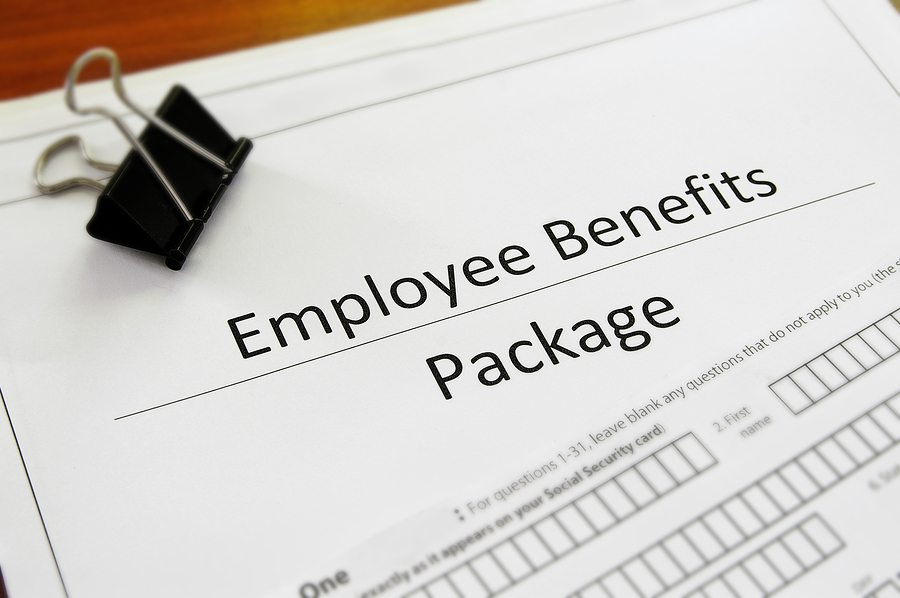by jeffp | Jan 25, 2016 | Employee Benefits

A successful business and a competitive employee benefits package go hand in hand; you’ll rarely find one without the other. Not only do generous perks attract more job candidates to your company, they also help you minimize employee turnover, improve morale and increase productivity. But don’t stop at paid time off and a 401(k) plan. Consider these voluntary employee benefits you should add today.
Critical Illness/Cancer Insurance – Supplemental critical illness and cancer policies are becoming increasingly popular with American workers. A Hartford study found that Generation Y workers participate in these programs at a higher rate, so they may be a particularly attractive addition to your benefits package if you’re recruiting or employing younger workers.
Accident Insurance – With the cost of health insurance under the Affordable Care Act driving many consumers to bronze plans with higher deductibles and out of pocket expenses, accident insurance offers your employees welcome peace of mind should they break a leg skiing or suffer an injury-causing fall at home.
Hospital Indemnity Insurance – If you have a lot of employees with high-deductible bronze-level health insurance coverage, hospital indemnity insurance will help them pay any hospital-related expenses their regular plan does not cover. This can significantly reduce their out of pocket costs for hospital stays, outpatient services and tests such as MRIs and CT scans traditionally performed at hospitals.
Integrated Long-Term Care and Life Insurance – As some carriers have stopped offering standalone long-term care products, others have begun to bundle long-term care and life insurance into one attractive package. The long-term care benefits, which your employees can use for future long-term care, home health care, assisted-living care and adult daycare, are usually bundled with a universal life policy.
Life Insurance and Disability – One third of U.S. households don’t have an individual life insurance policy or have a life insurance gap. Employers who offer their workers a supplement life and disability plan have the opportunity to make a real impact on their financial wellbeing.
Dental and Vision – When employers cut back on benefits during the economic downturn, many eliminated the supplemental dental and vision plans they previously offered their employees. However, as consumers’ out of pocket healthcare costs have continued to increase, their desire for these types of benefits has grown. Regardless of their age, your employees are likely to appreciate the opportunity to purchase this type of supplemental coverage again.
Legal insurance – When an employee suffers a personal problem—such as a home foreclosure, bankruptcy or divorce—it can have a negative effect on his or her productivity at work. Some employers are adding supplemental legal insurance to their benefits package to provide their staff with affordable solutions. Coverage varies by plan but generally includes access to a network of attorneys as well as free educational tools and resources.
The unexpected expense of a critical illness, accident, hospitalization, disability or legal difficulty would financially devastate most employees. In fact, according to the most recent MetLife Employee Benefits Trends Study, only 3 percent of workers report having a three-month’s salary cushion of savings to help them through a tough time. Talk to your benefits advisor about adding a few of these supplement insurance products today.
by jeffp | Jan 12, 2016 | Employee Benefits
 A required minimum distribution, or RMD, is the minimum amount one must withdraw from an IRA or retirement account each year. RMDs typically kick in after the owner of the account turns 70.5, and if your company offers any sort of employer-sponsored retirement plan (including profit-sharing plans, 401(k) plans, 403(b) plans and 457(b) plans) you could face serious consequences if your 70.5 and up workers fail to meet the RMD requirements.
A required minimum distribution, or RMD, is the minimum amount one must withdraw from an IRA or retirement account each year. RMDs typically kick in after the owner of the account turns 70.5, and if your company offers any sort of employer-sponsored retirement plan (including profit-sharing plans, 401(k) plans, 403(b) plans and 457(b) plans) you could face serious consequences if your 70.5 and up workers fail to meet the RMD requirements.
Consider the following employer RMD responsibilities as well as the steps you should take to protect your invested workers and your plan, from alerting participants who are approaching RMD age to activating the fund withdrawal.
Employers are ultimately responsible for RMDs. Although your employee should make an effort to understand the minimum distribution requirements of the employer-sponsored retirement savings plan, making sure RMDs happen is ultimately your responsibility. You should notify participants age 70.5 or older in advance of the filing deadline each year and, if they fail to file for distribution, you should set the process in motion yourself to protect your company’s retirement savings plan.
Employers must educate their employees. Do your employees know that they’ll pay a 50 percent penalty tax on the distribution amount if they fail to take the RMD? In addition, if they fail to file for their RMD, they will need to submit specific forms to the IRS to amend the situation. While penalty waivers are possible, they require a letter detailing the unforeseen circumstances leading to the error.
Employers face penalties, too. If the employer-sponsored retirement plan fails to distribute an RMD, whether that failure is your employee’s fault or your own, the plan may be subject to consequences such as losing tax-qualified status and elimination of your tax deduction for employer contributions. As soon as you realize you’ve missed a distribution, you must contact the IRS and begin the reconciliation process as outlined by the Employee Plans Compliance Resolution System.
You can correct your mistakes. If you miss an RMD, you can correct your mistake using the IRS’s Self-Correction Program without paying a fee—provided you’ve made an “insignificant operational mistake” or a “significant operational mistake” that you are correcting within the required timeframe outlined by the IRS. You may also choose the Voluntary Correction Program if you prefer written IRS approval of your correction, though the VCP does require payment of a fee.
It’s essential you monitor your employee’s RMDs if you want to ensure your employer-sponsored retirement plan maintains its tax-preferred status. Contact your benefits expert for additional insight on retirement plan RMDs or to discuss benefit administration services you may find helpful.
by jeffp | Dec 22, 2015 | Employee Benefits

Retirement concerns are on the minds of many Americans. According to the National Institute on Retirement Security, a non-profit research and education organization that recently conducted a survey on the subject, 83 percent are concerned that current economic conditions will affect their retirement. Additionally, 70 percent believe it is harder to retire today than it was for previous generations—and many are planning to remain in the workforce longer as a result.
While we wouldn’t wish the distress of perceived financial insecurity on anyone, the situation does present an opportunity for employers to leverage benefits including retirement planning education and assistance to their advantage—helping their workers in the process.
Job Seekers Consider Benefits Packages
A survey conducted by Monster.com, an online employment solution, found that most job seekers consider the benefits packages of employers before accepting an employment offer. While it’s not surprising that 32 percent of the respondents ranked a healthcare plan as the most important benefit package component, 8 percent preferred an employer-sponsored retirement plan.
While one might think a retirement plan would hold more attraction for older workers, it is not always the case. According to ADP Research Institute, 66 percent of younger professionals are counting on more help from their employers to achieve financial security through benefits. Only 31 percent of older workers feel the same way.
A survey conducted by ManpowerGroup, an employment firm, found 52 percent of American employers were having difficulty finding suitable talent to fill job openings—even though national unemployment remains high. In an environment where you face considerable competition for the best workers, including retirement planning education, assistance and a 401(k) in your benefits package could increase your chances of landing top candidates.
Benefits Also Impact Employee Retention
Fifty-nine percent of employees say that retirement benefits influence their company loyalty according to ADP Research Institute. It’s easy to see why. Data from the Employee Benefits Research Institute shows that 64 percent of employees enrolled in employer-sponsored retirement plans feel confident in their ability to save enough money to retire comfortably. Only 48 percent of those who do not participate in such a program can say the same.
Consider Worker Preferences When Designing a Retirement Plan Benefit
If you want to get the greatest benefit from an employer-sponsored retirement plan, you need to design it in a way that will attract most of your employees—and these days that means Generation X and Generation Y workers. These professionals value continuous access to educational tools and resources online as well as integration with social media and mobile applications. They are also drawn to newer 401(k) options such as automatic opt-in and target date funds according to ADP.
Whether you already offer retirement planning education and assistance as part of your benefits package or have recently begun considering the merits of such a move, talk with your benefits provider to learn more about creating the optimal win-win situation for your company and your employees.
by jeffp | Dec 8, 2015 | Employee Benefits

Do you include employee training and development in your benefits package? You should—research has revealed that workers consider such benefits when deciding whether to accept a new position or stay with their current employer. In fact, one study conducted by The Society for Human Resource Management discovered a direct correlation between employee turnover and development opportunities—or the lack thereof.
Unfortunately, not all employee-training investments represent time and money well spent. According to training experts, many companies make mistakes that severely reduce the benefit of their training programs. Consider the following missteps you should avoid when offering an employee training opportunity.
- Avoid large groups. It’s difficult to have a productive discussion with dozens of people in the room—particularly if you want all employees present to participate. When possible, limit training sessions to a dozen or fewer workers at a time and everyone will feel more comfortable chiming in.
- Avoid pointless games. Creative team-building activities may sound like a fun way to capture your employees’ interest and break the ice, but make sure they have a direct relation to the goal of the training. If they don’t, it will be harder to get all of your workers to participate.
- Avoid complicated training materials. While different workers will have different learning styles—such as visual, auditory and kinesthetic—keeping the material simple will enhance the experience of all. This is another area where multiple small training groups can be beneficial, allowing you to fine-tune your presentation based on the questions in each previous session.
- Avoid the lecture. Unless you want your employees to spend the session doodling in their notebook or checking Facebook on their cell phone, don’t hire trainers who rely on lectures. Instead, look for professionals who are adept at initiating and steering conversations without dominating discussions. The more he prompts your employees to participate, the more they will engage in the opportunity.
- Avoid irrelevant information. Training opportunities that are directly connected to your employees’ jobs and development goals are always better investments than those that focus on information or ideas that are not immediately applicable. The easiest way to determine the training your workers would most like to receive is to survey them on the topic.
- Avoid discomfort. Uncomfortable chairs, an air conditioner on the fritz, and too many noisy distractions will sap the attention of any employee. For best results, hold your employee training sessions in a comfortable, quiet room. If you must meet during normal lunch hours, make sure you provide refreshments as well.
Some studies have shown training programs can increase employee retention by as much as 70 percent. When you consider the expense that goes into finding, hiring and onboarding replacement workers, it’s easy to see that greater retention is better for your company’s bottom line. If you’d like further advice on implementing a program at your organization, consult your benefits advisor.
by jeffp | Nov 20, 2015 | Employee Benefits

Recently, the Society for Human Resource Management (SHRM) conducted several surveys of their members. In one, 20 percent of organizations reported leveraging benefits packages to retain workers. That number is surprisingly low given how effective desirable benefits can be for keeping staff happy, engaged and committed to their employers.
For example, one MetLife survey found that 58 percent of employees say benefits are one reason they remain with their employer. That percentage jumps to 63 percent for Generation Y workers and 62 percent for those in Generation X. In the same survey, 61 percent of employees who are very satisfied with the company benefits package they receive feel a strong sense of loyalty towards their employers. Only 24 percent of those very dissatisfied with their benefits feel the same loyalty.
Most Common Benefits
Most employers view health insurance and retirement savings benefits as the most important for employee retention. In the SHRM survey mentioned earlier, 72 percent of the organizations reported leveraging health insurance—including medical coverage and flexible spending accounts—to retain valuable employees. Fifty-eight percent relied on retirement savings benefits—including 401k and stock options, to do the same. Other commonly offered benefits include paid holidays, paid vacation and sick time, and supplemental insurance plans including vision, dental, life and disability.
Benefits Most Employees Want
While 90 percent of employees consider health insurance most important according to The Principal Financial Group, it’s not the only thing they find attractive in a benefits package. For example, a study by the Families and Work Institute found that 87 percent of employees say the flexibility to balance work and personal life is “extremely” or “very” important.
When structuring an employee benefits package that will keep your staff happy and engaged in their work, it’s important to survey them and find out what they really want. Then think outside the box when exploring ways to satisfy their needs. You’re likely to find some benefits—like their birthday off and PTO plans that combine personal, sick and vacation time—that you can offer at little to no cost.
Other benefits popular with today’s workforce include onsite childcare, onsite fitness classes, health and lifestyle coaching, wellness program bonuses, referral bonuses, one-on-one investment advising, flexible schedules (including four-day workweeks), telecommuting opportunities, leadership training and career development programs.
Structuring a Package
There are no one-size-fits-all formulas for benefits offerings. Every business needs a plan tailored for its specific needs. Working with an advisor is the best way to structure a package for your workforce, not only to ensure you meet state and federal benefits regulations, but also to provide insight into costs and the needs of your particular organization.
Remember, happy workers are engaged in their jobs, increasing business productivity. They’re also less likely to leave for greener pastures, reducing your company’s hiring and training costs. While a solid employee benefits package may require a financial investment, the long-term benefits will be more than worth the expenditure.


 A required minimum distribution, or RMD, is the minimum amount one must withdraw from an IRA or retirement account each year. RMDs typically kick in after the owner of the account turns 70.5, and if your company offers any sort of employer-sponsored retirement plan (including profit-sharing plans, 401(k) plans, 403(b) plans and 457(b) plans) you could face serious consequences if your 70.5 and up workers fail to meet the RMD requirements.
A required minimum distribution, or RMD, is the minimum amount one must withdraw from an IRA or retirement account each year. RMDs typically kick in after the owner of the account turns 70.5, and if your company offers any sort of employer-sponsored retirement plan (including profit-sharing plans, 401(k) plans, 403(b) plans and 457(b) plans) you could face serious consequences if your 70.5 and up workers fail to meet the RMD requirements.



